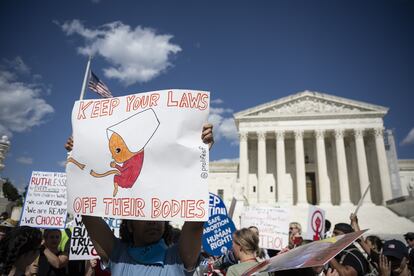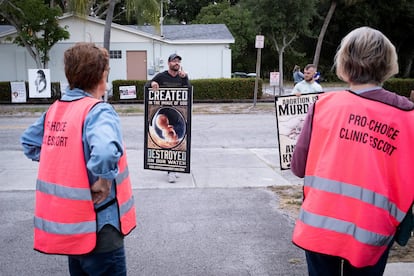Abortions register slight increase in US despite bans in 14 states following ‘Roe v. Wade’ reversal
A new report shows telehealth procedures have increased by 16% since the Supreme Court struck down the federal right to abortion in 2022


The 14 states that have banned voluntary pregnancy terminations since the Supreme Court struck down the federal right to abortion in the United States two years ago have not been able to break the will of those who want or need the procedure. Since the 2022 ruling overturning Roe v. Wade, the average number of abortions performed each month in the U.S. has been increasing, reaching an average of 98,990 per month between January and March of this year. This represents 14% more than the average for the same period in 2023, or about 12,000 more abortions per month, according to a report released Wednesday.
The data compiled by #WeCount, a research project of the Society of Family Planning, portrays how the country has shifted to either shield or restrict women’s reproductive health rights 21 months after the Supreme Court struck down the landmark 1973 precedent and returned power to legislate abortion to the individual states. More than 25 million women now live in abortion-restricted territories and face great difficulty in accessing the procedure. Telecare allows them to access online medical consultations and receive necessary medication.
The report comes just three months before the presidential election that will pit Kamala Harris, a staunch defender of abortion rights, against Donald Trump, who during his previous administration appointed three Supreme Court justices with the express mission of overturning Roe.
It is expected that with Harris installed as the new Democratic candidate after the withdrawal of Joe Biden, abortion will mobilize the Democratic electorate who see in the current vice president a protector of this right. Beyond the Harris-Trump duel for the presidency, abortion will be on at least six state ballots, where voters will have the opportunity to enshrine or reject abortion protection. So far, in the seven states where popular consultations have been held, voters have decided to protect women’s freedom of choice.
#WeCount began recording the number of abortions performed nationally and by state after the Supreme Court ruling in June 2022. Since then, the pro-choice initiative has published its findings in quarterly reports. Its latest, with data from the first three months of this year, shows that 102,350 abortions were performed nationwide in January alone, the first time more than 100,000 procedures have been recorded in a single month since the high court’s ruling. That figure represents 17,660 more abortions than in April 2022 and 18,280 more than in May 2022, the two months prior to the ruling.
#WeCount point out that this upward trend, despite the avalanche of restrictions against the procedure that occurred in the most conservative states after the court’s ruling, is due to the fact that there has been a notable increase in the number of abortions performed remotely, through telehealth. This option has risen from representing only 4% of all abortions performed in the U.S. in April 2022 to 20% today.

Between January and March of this year, there were around 19,700 telehealth abortions per month, including those performed in physical clinics, virtual clinics and under the protections of so-called shield laws. These laws protect doctors practicing in states where abortion remains legal from potential ramifications for prescribing abortifacient drugs via telehealth to people living in states where the procedure is banned or restricted. In all, six Democratic states — Massachusetts, Washington, Colorado, Vermont, New York and California — have passed shield laws to only one Republican state: Maine.
Thanks to these shield laws, between January and March, 27,660 abortions — 9% of the total — were performed through telehealth. And since these laws began to take effect during the summer of last year, more than 65,000 people have been able to access the procedure despite residing in states where abortion is either completely banned or restricted after the sixth week of pregnancy — when most people are unaware they are pregnant — and in states where access to telemedicine is limited.
“Telehealth abortion is making a critical difference for people seeking abortion care in this increasingly restrictive environment,” Ushma Upadhyay, MD, co-chair of #WeCount and professor of reproductive health at the University of California, San Francisco, said in a statement Wednesday.
Surge in states bordering states that ban abortion
The report reveals that the number of abortions increased in states that border states that ban or restrict the procedure. In part, this increase is because more people are moving from states where they cannot have abortions to territories where they are legal, according to #WeCount. This is the case in Illinois, which is completely surrounded by states that have restricted access to abortion, including three that have banned it altogether: Missouri, Indiana, and Kentucky. In the first three months of the year, Illinois registered the third-highest average number of abortions.
“While the volume of abortions has increased, we know that this isn’t the full story,” said Alison Norris, M.D., co-chair of #WeCount and professor at The Ohio State University’s College of Public Health. “Even as we see the increase in abortion volume nationally, the burden on an individual living in a state with an abortion ban is enormous, especially if they need in-person abortion care.”
Abortions have virtually ceased in the 14 states that have enacted bans since the ruling overturning Roe v. Wade. #WeCount estimates that, if these bans did not exist, 208,040 abortions would have occurred in those 14 states in the 21 months since the Supreme Court ruling. In other words, these bans are preventing nearly 10,000 in-person abortions from occurring in those states every month.
The states with the largest cumulative declines in abortion volume since the Supreme Court ruling are Texas (64,710), Georgia (39,245), Tennessee (24,775), Louisiana (16,175) and Alabama (13,335). In four of the five, abortion is prohibited, except in Georgia, where it is prohibited after the sixth week.

Florida and the southeastern U.S.
The #WeCount researchers highlight the case of Florida, where until last March the number of abortions performed was on the rise. However, the data handled by the organization does not reflect the change in state legislation: as of May 1, 2024, Florida bans abortion after the sixth week of pregnancy. The so-called “heartbeat law” amounts to virtually a total ban, as do similar laws in effect in Georgia, Iowa, and South Carolina.
For #WeCount, the Florida law will have repercussions beyond the state, “given the relatively high number of abortions” that were performed there before the new rule went into effect. After the Supreme Court ruling, Florida had become a recipient of patients from other parts of the southeastern U.S., where there are seven states that have banned the procedure. As of March, the number of monthly abortions in Florida ranged from 6,000 to 8,000.
The future of abortion rights in Florida and in the Southeast in general will be decided later this year. On November 5, the day of the presidential election, the state’s residents will also vote on a constitutional amendment that, if passed, would legalize abortion up to viability, which is generally considered to be around 23 to 24 weeks of pregnancy. At least 60% must vote in favor to add this measure to the state constitution.
Sign up for our weekly newsletter to get more English-language news coverage from EL PAÍS USA Edition
Tu suscripción se está usando en otro dispositivo
¿Quieres añadir otro usuario a tu suscripción?
Si continúas leyendo en este dispositivo, no se podrá leer en el otro.
FlechaTu suscripción se está usando en otro dispositivo y solo puedes acceder a EL PAÍS desde un dispositivo a la vez.
Si quieres compartir tu cuenta, cambia tu suscripción a la modalidad Premium, así podrás añadir otro usuario. Cada uno accederá con su propia cuenta de email, lo que os permitirá personalizar vuestra experiencia en EL PAÍS.
¿Tienes una suscripción de empresa? Accede aquí para contratar más cuentas.
En el caso de no saber quién está usando tu cuenta, te recomendamos cambiar tu contraseña aquí.
Si decides continuar compartiendo tu cuenta, este mensaje se mostrará en tu dispositivo y en el de la otra persona que está usando tu cuenta de forma indefinida, afectando a tu experiencia de lectura. Puedes consultar aquí los términos y condiciones de la suscripción digital.
More information
Archived In
Últimas noticias
The impact of Ecuador’s mega-prison: A polluted river, cleared forests and military checkpoints
Corinne Low: ‘I’m more concerned about the female happiness gap than the gender wage gap’
Trump traveled on Epstein’s plane ‘many more times’ than previously thought, according to new documents
Venezuelan exiles in Madrid scramble to salvage Christmas plans after flight cancellations
Most viewed
- The low-cost creative revolution: How technology is making art accessible to everyone
- Christian Louboutin: ‘Young people don’t want to be like their parents. And if their parents wear sneakers, they’re going to look for something else’
- All the effects of gentrification in one corner of Mexico’s Colonia Roma
- Liset Menéndez de la Prida, neuroscientist: ‘It’s not normal to constantly seek pleasure; it’s important to be bored, to be calm’
- Christmas loses its festive spirit: ICE fears cast shadow over religious celebrations










































